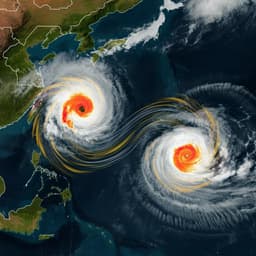
Earth Sciences
US Gulf Coast tropical cyclone precipitation influenced by volcanism and the North Atlantic subtropical high
J. C. Bregy, J. T. Maxwell, et al.
Explore a groundbreaking 473-year reconstruction of tropical cyclone precipitation from longleaf pine in southern Mississippi. This study reveals how volcanic eruptions impact rainfall patterns and highlights significant correlations with the North Atlantic high-pressure system and multidecadal variability, conducted by authors Joshua C. Bregy, Justin T. Maxwell, Scott M. Robeson, Grant L. Harley, Emily A. Elliott, and Karen J. Heeter.
~3 min • Beginner • English
Introduction
Tropical cyclone precipitation (TCP) is a major, often overlooked hazard that drives inland flooding, the leading cause of TC-related fatalities, and influences water resources and ecosystems in the southeastern United States. Climate models project increased TCP rates with anthropogenic warming due to slower storm translation, warmer sea surface temperatures, and higher moisture content. Yet observational datasets of TC activity (HURDAT2 since 1850; TCPDat since 1948) are too short to capture the full range of variability or to robustly attribute changes. Existing paleotempestology records, often from overwash sediments, emphasize only the most intense storms and lack annual resolution. Annual-resolution TCP reconstructions from tree rings exist for the Carolinas but not for the Gulf Coast. This study reconstructs July–September TCP for the Mississippi Gulf Coast from 1540–2012 CE using longleaf pine tree rings to: (1) characterize interannual to multidecadal variability in TCP, and (2) assess climatic controls including the North Atlantic subtropical high (Bermuda High), volcanic forcing, and Atlantic multidecadal variability (AMV).
Literature Review
Paleohurricane reconstructions commonly use coastal overwash and other sedimentary archives to infer storm frequency, intensity, and surge heights over centennial–millennial scales, but these records preferentially capture the most intense events and depend on site geomorphology and storm characteristics. Annually resolved proxies (speleothem isotopes, tree rings) are less common and typically reconstruct TC presence/activity rather than precipitation. Prior tree-ring studies using longleaf pine in the Carolinas produced TCP estimates since the 1700s. The literature highlights the need for high-resolution, annually resolved TCP reconstructions to bridge gaps in the instrumental era and complement event-based sediment records. Climatic influences on Gulf Coast precipitation and TCs include the North Atlantic subtropical high, North Atlantic Oscillation, and multidecadal SST variability (AMV), but short instrumental records limit understanding of these relationships.
Methodology
Study area and sampling: Longleaf pine (Pinus palustris) samples were collected in 2012–2013 across microhabitats in Mississippi’s De Soto National Forest (DNF), a humid subtropical region strongly influenced by TCP. To extend chronology length despite regional logging-related loss of old trees, wood from remnant stumps, wooden coffins from the Mississippi State Asylum Cemetery, and the Deason House (Ellisville, MS) was included, all sourced from DNF based on archival receipts.
Dendrochronology and measurements: Cores and cross-sections were prepared using standard techniques, sanded to reveal ring structure, scanned and measured (WinDendro). Earlywood and latewood widths were measured along dated transects. Cross-dating was visually and statistically confirmed with COFECHA, anchoring archaeological and remnant samples to dated living-tree series. Series were detrended with ARSTAN using two-thirds smoothing splines with recommended endpoint adjustments to remove biological growth trends.
Adjusted latewood index (LWa): To isolate late-season moisture from antecedent influences, latewood width was regressed on earlywood width at the series level; residuals were retained and shifted by +1 to produce the adjusted latewood index (mean ≈ 1). This series-level approach minimizes non-climatic microsite effects.
Instrumental data and screening: Seasonal TCP totals (July 1–Sept 30) at the DNF grid cell (TCPDat) were summed for 1948–2012. Non-TCP and total precipitation were also extracted. Correlations between LWa and TCP, non-TCP, and total precipitation at lags t and t+1 were evaluated; only significant relationships were retained. LWa correlated most strongly with TCP (r ≈ 0.64) versus non-TCP (r ≈ 0.40) and total precipitation (r ≈ 0.54).
Reconstruction model: A linear regression of instrumental seasonal TCP on the LWa chronology over 1948–2012 was used to reconstruct TCP back to 1540 CE (final record limited by sample depth). Calibration/validation used split-sample tests (early/late halves and full period) with R², reduction of error (RE), and coefficient of efficiency (CE); RE and CE were positive throughout, indicating predictive skill and temporal stability. A Bootstrapped Transfer Function Stability test (1,000 resamples) found no instability (all parameter p-values > 0.05) and yielded positive bootstrapped RE (0.140) and CE (0.110). The model explained ~40% of instrumental TCP variance (R² ≈ 0.41). TCP autocorrelation was assessed; the annual series showed no significant persistence. EPS and RBAR at the cutoff date were 0.815 and 0.321, respectively.
Climate controls analyses: The Bermuda High Index (BHI; meridional pressure gradient between New Orleans and Bermuda) was seasonally weighted by monthly TC landfall frequency and correlated (Spearman) with instrumental and reconstructed TCP (1948–2012). Volcanic forcing was assessed via superposed epoch analysis (R package dplR) using eruptions likely to affect regional or global climate (VEI ≥ 6 for NH/equatorial eruptions; VEI ≥ 4 for proximate North American events not east of the site). Multidecadal variability was examined against the annually resolved 1,200-year AMV reconstruction (Wang et al. 2017) using cross-correlation of detrended annual series and moving averages (25–45-year windows), with confidence intervals adjusted for autocorrelation following established methods. Cross-wavelet analysis (xwt) further explored timing/phase. A Mg/Ca- and δ18O-based SST reconstruction for the northern Gulf of Mexico (proxy for Loop Current/AWP variability) provided qualitative context for multidecadal TCP behavior; its temporal resolution precluded robust correlation testing.
Key Findings
- The 473-year annually resolved reconstruction (1540–2012 CE) is the longest TCP record to date and the first for the U.S. Gulf Coast. The model explains ~40% of instrumental TCP variance; LWa–TCP calibration correlation r ≈ 0.64 (p < 0.001).
- Reconstructed mean seasonal TCP is 28.8 mm yr⁻¹. Nineteen years exceed 100 mm (96th percentile), and five exceed 157 mm (99th percentile): 1569, 1749, 1888, 2005, and 2012 CE.
- The annual series shows little autocorrelation (year-to-year persistence is weak), but multidecadal variability is evident, with alternating wet/dry intervals. Frequency of high-TCP years (≥42.2 mm; Q4) varies on multidecadal scales.
- North Atlantic subtropical high influence: Seasonally weighted BHI is significantly correlated with both instrumental and reconstructed TCP during 1948–2012. A more westward western flank of the subtropical high corresponds to reduced TCP along the north-central Gulf Coast, and an eastward position corresponds to increased TCP.
- Volcanic forcing: Superposed epoch analysis shows TCP declines significantly in the two years following selected eruption events before returning to near-normal values, consistent with reduced TC activity post-eruption. The early–mid 1800s decline in TCP coincides with multiple major eruptions (e.g., Tambora, 1815).
- AMV link: Interannually, TCP and AMV correlate weakly (r ≈ 0.11; p < 0.05), with indications that AMV leads TCP by several years. On multidecadal scales, TCP and AMV co-vary (r ≈ 0.56–0.61; p < 0.05) and are generally in-phase after accounting for autocorrelation and smoothing effects.
- Regional oceanography: Multidecadal TCP behavior aligns with reconstructed SST variability in the northern Gulf of Mexico, suggesting that expansions of the Atlantic Warm Pool and northward-displaced Loop Current favor wetter TCP phases along the northern Gulf Coast.
Discussion
This reconstruction resolves interannual to multidecadal variability in Gulf Coast TCP beyond the instrumental era and identifies key climatic controls. The significant post-eruption declines in TCP indicate sensitivity of regional TC activity to external radiative forcing from explosive volcanism. The significant relationship with the Bermuda High’s western flank demonstrates that synoptic-scale circulation modulates landfall locations and TCP distributions. Although the interannual TCP–AMV correlation is weak, the robust multidecadal co-variability and lead of AMV suggest basin-scale SST regimes condition environmental favorability (via the Atlantic Warm Pool, vertical wind shear, and convective instability) that ultimately influences TCP over the Gulf Coast. The correspondence between TCP and northern Gulf SSTs implicates the Loop Current/AWP as proximal modulators of TCP intensity and frequency. Collectively, these results address the study’s goals by quantifying long-term TCP variability and elucidating climate drivers across timescales critical for regional hazard assessment.
Conclusion
The study provides the first Gulf Coast, annually resolved TCP reconstruction spanning 1540–2012 CE, quantifies multidecadal variability, and identifies significant climatic controls: (1) a decline in TCP in the two years following major volcanic eruptions, (2) sensitivity to the position/intensity of the North Atlantic subtropical high’s western flank, and (3) a weak interannual but significant multidecadal linkage with AMV, likely mediated by the Atlantic Warm Pool and Loop Current. These findings extend context for flood risk and hydroclimate variability in a warming climate. Future research should develop a regional network of TCP reconstructions across the southeastern U.S., leverage unconventional longleaf pine sources (e.g., coffins, historical structures), test other southern pine species, and integrate proxy reconstructions with millennial-scale reanalyses and ocean–atmosphere model frameworks to resolve mechanisms and improve risk assessments.
Limitations
- Spatial limitation: A single-site reconstruction may capture local to regional signals; a broader network is needed for basin-wide inference.
- Instrumental calibration length (1948–2012) is relatively short and may not encompass full variability of climate controls.
- Proxy behavior: LWa slightly overestimates TCP at low precipitation totals; sensitivity may vary with microtopography and soils.
- AMV relationship is weak at interannual scales; smoothing can inflate correlations; confidence intervals were adjusted, but residual uncertainties remain.
- Loop Current/SST reconstruction resolution is too low for robust correlation, limiting quantitative assessment.
- Pre-1540 sample depth declines, constraining the start year; uncertainties inherent in dendrochronological standardization and detrending persist.
Related Publications
Explore these studies to deepen your understanding of the subject.







